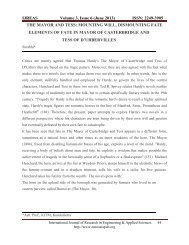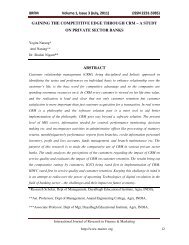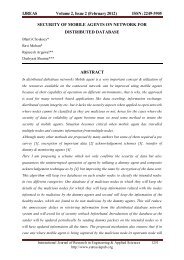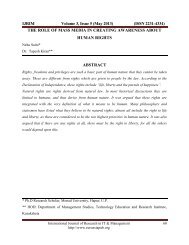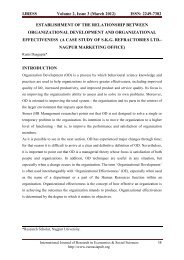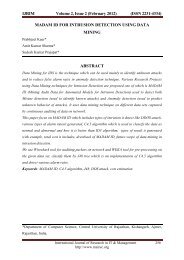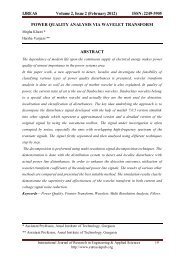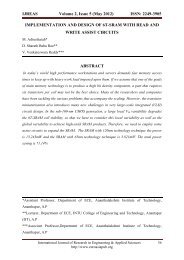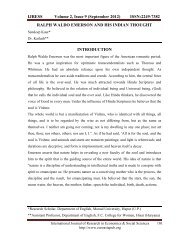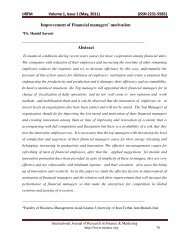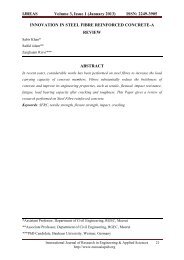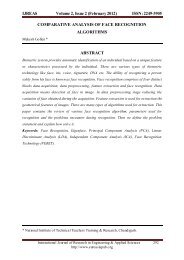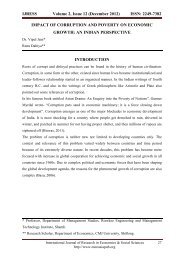shakespeare's sonnets - a critical analysis - Euroasiapub.org
shakespeare's sonnets - a critical analysis - Euroasiapub.org
shakespeare's sonnets - a critical analysis - Euroasiapub.org
You also want an ePaper? Increase the reach of your titles
YUMPU automatically turns print PDFs into web optimized ePapers that Google loves.
IJRESS Volume 2, Issue 9 (September 2012) ISSN: 2249-7382<br />
The Letters Patent of the company specifically charged Shakespeare and eight others “freely to<br />
use and exercise the art and faculty of playing Comedies, Tragedies, Histories, Morals, Pastorals,<br />
stage plays as well for recreation of our loving subjects as for our solace and pleasure.”<br />
Shakespeare entertained the king and the people for another ten years until June 19, 1613, when<br />
a canon fired from the roof of the theatre for a gala performance of Henry VIII set fire to the<br />
thatch roof and burned the theatre to the ground. The audience ignored the smoke from the roof<br />
at first, being too absorbed in the play, until the flames caught the walls and the fabric of the<br />
curtains. Amazingly there were no casualties, and the next spring the company had the theatre<br />
“new build in a far fairer manner than before.” Although Shakespeare invested in the rebuilding,<br />
he retired from the stage to the Great House of New Place in Stat-ford that he had purchased in<br />
1597, and some considerable land holdings, where he continued to write until his death in 1616<br />
on the day of his 52nd birthday.<br />
In his time William wrote 13 Comedies, 13 Historical Plays, 6 Tragedies, 4 Tragicomedies, as<br />
well as many <strong>sonnets</strong> (154) , which were mostly dedicated to his patron, Henry Wriothsley, The<br />
Earl of Southampton.<br />
BACKGROUND OF SHAKESPEARE'S SONNETS<br />
Like all of Shakespeare's <strong>sonnets</strong>, Sonnet 146 was probably written in the mid to late 1590s.<br />
While the <strong>sonnets</strong> of Sidney, Spenser, and other contemporaries celebrate idealized women,<br />
Shakespeare's <strong>sonnets</strong> are often introspective, brooding, and enigmatic. Sonnets 1 through 126<br />
are addressed; it is generally agreed, to a beautiful young man. Twenty-six subsequent poems<br />
deal with an unfaithful, physically unattractive, yet somehow irresistible “dark lady.”<br />
Shakespeare circulated his <strong>sonnets</strong> among friends and acquaintances; he probably never intended<br />
for them to be published.<br />
Shakespeare's <strong>sonnets</strong> are considered to be among the best of the Elizabethan sonnet form, a<br />
style that was popular during his time. His precise tonal and textural control of language,<br />
combined with witty and often surprising turns of metaphors and ideas, often display<br />
Shakespeare's strongest capabilities.<br />
SONNET 4<br />
The themes of narcissism and usury (meant here as a form of use) are most developed in this<br />
sonnet, with its references to wills and testaments. The terms “unthrifty,” “legacy,” “bequest,”<br />
and “free” (which in line 4 means to be generous), imply that nature's generosity should be<br />
International Journal of Research in Economics & Social Sciences 66<br />
http://www.euroasiapub.<strong>org</strong>



